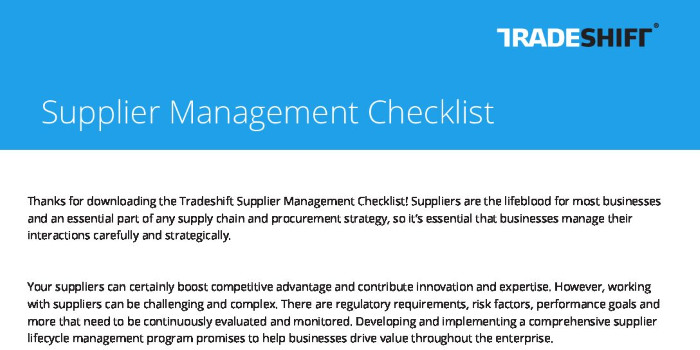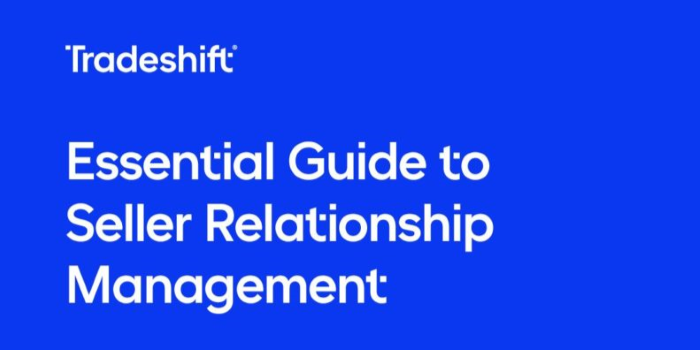Supplier Relationship Management
Improving your Vendor Relations
Rather than just pushing your suppliers through automated portals, Tradeshift allows you and your suppliers access to collaborative tools and analytical capabilities to help you create a highly efficient and strategic supply chain.

Bring your sellers closer.
Tradeshift Engage is the only solution that gives sellers free access to powerful collaboration and analytics tools along with predictable, prompt payments.
You may also be interested in…
The Benefits of Investing In Supplier Relationship Management
Having a network of suppliers is good. But connecting to that network with a strong supplier relationship management strategy adds value…
Essential Guide to Supplier Management
Do you have a handle on your supplier network? Many large companies have hundreds – if not thousands – of suppliers around the world to manage, which can easily lead to outdated data, sloppy databases, and shaky security.
Supplier Relationship Management - The Essential Guide
Learn everything about seller relationship management in our complete guide.
Supplier Relationship Management - FAQ
Supplier relationship management (SRM) is the process of evaluating suppliers and identifying which relationships are essential to the business. In many organizations, as their supply chain grows, the relationships with suppliers become more complex. Supplier relationship management helps companies ensure that they invest in the relationships that contribute to and matter most for their success.
The core functions of supplier relationship management are:
- Vendor
Review and evaluate your existing vendors and understand how to improve supplier performance to meet your current and future needs. Click here to learn more about how to optimize your supplier relationship management. - Strategic Alliance
Collaborate with suppliers to improve supplier quality. When you embrace a strategic alliance, both organizations collaborate and modify their processes to help achieve their goals. Read more about the types of supplier relationship management here. - Partnership
Manage your data more effectively and make your suppliers happy. Discover our supplier management guide to get started on building stronger, future-proofed relationships with your vendors.
The five central tenets SRM revolves around are the following:
- Mutual growth
- Value creation
- Trust between parties
- Open communication
- A win-win mindset
Additional Benefits:
Reduced costs
Your company saves money on sourcing, onboarding, and negotiations when you invest time and resources into maintaining your current suppliers.
Increased efficiency
Ensure your vendor relationships remain profitable, improve communications, and align your goals more closely.
- Broaden your definition of the value of SRM
- Get stakeholder buy-in as high up as possible
- Train everyone working with the suppliers, not just procurement people
- Use technology to kick-start your transformation
- Create joint account plans with suppliers to increase their value
There are three distinct stages of supplier relationship management:
- Supplier Segmentation
Buy the market
These suppliers and the products they sell are in high supply. The products you’re buying from buy-the-market suppliers are important, but your business won’t shut down without them, and they have no direct impact on profitability.
Ongoing
Many technology hardware suppliers will fit into this category. Suppliers in this category have mid-range contract lengths, perhaps longer than the standard one-year agreement but shorter than the more strategic five- to 10-year agreements.
Partnership
Suppliers in the partnership segment are those with longer-term contracts. Trust has been established, though the relationship is not exclusive. There is a moderate risk due to limited competition and a moderate risk to profitability.
Strategic alliance
Suppliers your company has a strategic alliance with are those you typically work with exclusively. There is a high risk due to minimal competition and profitability risk. A shutdown or outage could also be highly detrimental to your company.
Backward vertical integration
These are suppliers that your company has fully merged with to the point that they own the supplier. This is common in manufacturing environments where certain components are critical to daily operations. - Creation of Supplier Strategy
You’ll set goals, objectives, and expectations for each segment and KPIs to measure those. Additionally, you’ll make sure resources are available to meet these needs internally and with the suppliers. - Execution of Supplier Strategy
With buy-the-market suppliers, there may be very little to do here. But for your partnerships and strategic alliances, execution of the strategy will involve collaboration and ongoing evaluation and feedback.
A long-term relationship between your organization and its suppliers sets the tone for stronger collaboration now and in the future. By allowing the opportunity to share ideas, feedback, and questions, an SRM will create a more streamlined and effective supply chain that positively impacts your costs and customer service over time.
Improved value
A structured SRM system, like Tradeshift’s Engage, automates busy work and saves your company valuable time. Tradeshift Engage stores the data you need and offers core insights that aid in your decision-making. This greater visibility allows you to identify issues before they arise, creating a resilient and valuable relationship.
Loyalty
When you invest in your relationships, they invest in you. Having an SRM system to help you manage your suppliers creates a positive supplier experience, making them more likely to continue their relationship with you.
Supply chain management is the key component for the success of any business. SRM helps business leaders make better sourcing and purchasing decisions, mitigate vendor performance risks, and streamline communication with suppliers.
Our users choose Tradeshift to support their supply chain operations because of our:
Streamlined data
Tradeshift Engage’s analytical capabilities give sellers a quick dashboard view of payments and transactions.
Optimized collaboration
Tradeshift Engage users can easily collaborate on tasks, attach necessary documents and search for old records, all within our digital platform.
Embracement of digitization
The Tradeshift network acts as a digital hub to support and assist with your supply chain needs. Our online payments portal, Tradeshift Pay, helps you secure payments more quickly.
Organizations inherently understand the importance of building trust-based connections to strengthen their relationships with suppliers. If your suppliers are happy, you retain familiar partners, condense the number of suppliers you use, and grow to anticipate your suppliers’ needs.
Instead of spreading yourself thin trying to please a variety of suppliers that could jump ship, investing in these valuable relationships helps extend the lifespan of your partnerships as well as keep your supply chain healthy and agile. Tradeshift’s SRM platform will help you get there.
Supply chain digitization solutions (For Buyers):
B2B marketplace for E-procurement
AP Automation & E-Invoicing Solution
Supplier collaboration and analytics
Virtual Corporate Credit Card for Spend Management
Early Payments Solution for Working Capital Optimization
Supply chain digitization solutions (For Sellers):
Digital B2B Supplier Solutions | Tradeshift
Supplier Financing for Early Invoice Payments
To learn more, reach out to one of our experts or sign up for a free demo now.





